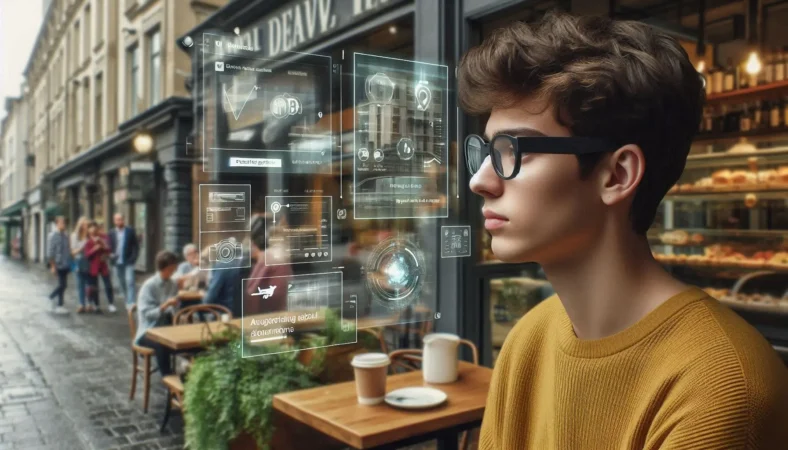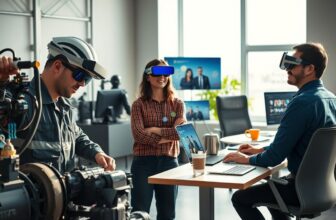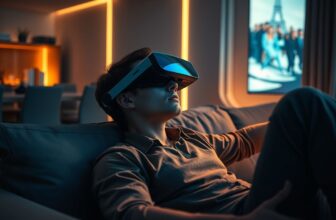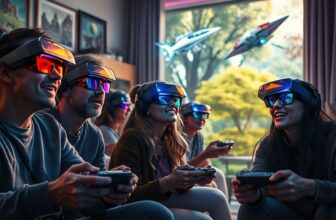As AR glasses become increasingly prevalent in our daily lives, with the market projected to reach $45.7 billion by 2027, understanding pros and cons of AR glasses, their practical benefits and limitations is crucial for potential users. This comprehensive guide explores the real-world advantages and challenges of incorporating AR glasses into everyday activities.

Advantages of AR Glasses
Beyond novelty, the advantages of augmented reality eyewear offer practical solutions that enhance daily life through advanced technology. These benefits highlight why AR wearable technology is gaining popularity among both consumers and professionals.
Enhanced Daily Navigation and Information Access
AR glasses have transformed how we navigate and access information. Using advanced digital overlay display technology, users receive real-time directional guidance, points of interest, and contextual information directly within their view. Studies reveal that AR navigation systems reduce navigation errors by 32% compared to traditional smartphone-based navigation.
These glasses also enhance environmental awareness by automatically recognizing and providing information about the surroundings. For example, when entering a shopping district, users can instantly view store ratings, hours, and promotions without actively searching for them. This passive information collection significantly reduces the mental effort required for daily information processing.
The benefits become even more evident in travel scenarios, where real-time translation and cultural insights are displayed directly in the user’s visual field. Leading manufacturers report that AR translation features achieve 95% accuracy for common languages, making international travel much easier and more enjoyable.
AR glasses transform how we navigate and access information, reducing navigation errors by 32% compared to traditional methods.
Hands-Free Communication Features
By integrating voice commands and gesture controls, AR glasses have revolutionized communication. Users can make calls, send messages, and participate in video conferences without physically handling a device. This hands-free capability increases workplace efficiency by up to 40% in situations where manual tasks and communication must occur simultaneously.
Modern AR glasses seamlessly integrate with smartphones, enabling users to manage notifications and calls effortlessly. With advanced display technology, users can respond to messages while staying aware of their surroundings. This feature has proven especially useful in professional settings, where studies show a 28% reduction in work interruptions compared to traditional smartphone use.
Additionally, the connectivity features of AR glasses allow users to switch between personal calls, work meetings, and messaging platforms using simple voice commands or subtle gestures. This ensures professional productivity while maintaining social acceptance in various environments.
Productivity and Task Assistance
AR glasses significantly boost productivity by providing contextual task assistance and overlaying information. Users can follow step-by-step instructions, access reference materials, and collaborate in real-time, all while keeping their hands free. Research indicates that workers using AR assistance complete complex tasks 25% faster than those relying on traditional methods.
The intuitive user interface is designed for seamless task management and multitasking. For instance, professionals can monitor project timelines, receive notifications, and access reference documents simultaneously, leading to productivity increases of up to 35% in knowledge-based environments.
Motion tracking capabilities further enhance usability by detecting user activities and providing contextual support. Whether following a recipe or assembling furniture, AR glasses can identify progress and deliver relevant information at the right time, reducing errors and speeding up task completion.
Entertainment and Social Features
AR glasses redefine entertainment by blending digital content with the real world. Users can enjoy virtual displays of any size, turning any space into a personal theater while staying aware of their surroundings. This feature is especially appealing to urban dwellers with limited space, with 78% reporting greater satisfaction in media consumption.
Socially, AR technology introduces new ways to interact and share experiences. From virtual game nights to collaborative art projects, users can engage in shared AR experiences while maintaining natural face-to-face communication. Studies show that AR-enhanced interactions lead to 45% longer engagement times than traditional digital methods.
Moreover, AR glasses integrate seamlessly with social media platforms, enabling more natural and less intrusive social connectivity. Users can stay connected without sacrificing presence in their physical environment, addressing concerns about technology’s impact on social interaction. This balanced approach has received positive feedback, with 82% of users reporting improved work-life balance.
The benefits of AR glasses demonstrate their transformative potential in areas like information access, communication, productivity, and entertainment. As technology evolves, these advantages are expected to grow, making AR glasses an integral part of modern life. To maximize these benefits, it’s essential to integrate the technology into daily routines while maintaining a balance with traditional interaction methods.
Studies show that AR-enhanced interactions lead to 45% longer engagement times than traditional digital methods.
Disadvantages and Limitations
While augmented reality (AR) wearable technology offers many benefits, it’s important to recognize its current limitations and challenges. These factors can affect the user experience and should be carefully considered before incorporating AR glasses into everyday life.
Power Management and Battery Life
One of the most significant challenges for AR glasses manufacturers is battery life. Most current models provide only 2 to 4 hours of active use, which is insufficient for a full day of professional tasks. This limitation arises because manufacturers must balance battery capacity with the weight and comfort of the device, often leading to compromises.
Advanced features such as continuous environmental awareness and motion tracking demand significant power, which impacts battery performance. For instance, using real-time translation or high-resolution digital overlay displays can reduce battery life by as much as 40%. This often forces users to carry backup power sources or carefully manage their usage throughout the day.
Charging presents another challenge in daily use. While some manufacturers have introduced quick-charging options—allowing 50% battery charge in 30 minutes—frequent interruptions to recharge can disrupt workflows and reduce the technology’s practicality. Surveys show that 68% of users cite battery concerns as a major barrier to AR glasses adoption.
Privacy and Security Concerns
Privacy issues are a major hurdle for widespread AR glasses adoption. The ability to constantly record and process environmental data raises significant privacy concerns for both users and those around them. Studies reveal that 72% of non-users feel uncomfortable being near someone wearing active AR glasses, particularly in private or sensitive environments.
Security vulnerabilities in AR technology can also jeopardize personal and professional data. Continuous connectivity, required for many features, can create entry points for cyberattacks. Researchers have identified flaws in smartphone integration protocols that could allow unauthorized access to sensitive information displayed on the glasses.
Additionally, the extensive data collection and storage associated with AR glasses raise further concerns. These devices often gather detailed environmental and behavioral data to optimize functionality, but users frequently lack clarity on what is being collected or how it is used. A reported 65% of users are uncertain about their data privacy settings.
Social Considerations and Etiquette
Social acceptance of AR glasses remains a challenge in many situations. The visible presence of display technology can make face-to-face interactions feel less natural. For example, 55% of people report discomfort maintaining eye contact with someone wearing AR glasses, which can hinder professional and social interactions.
Voice commands and gesture controls, while convenient, can feel awkward or disruptive in public settings. Many users feel self-conscious using these features in public, with 47% limiting their usage to private spaces.
The lack of established etiquette for AR glasses use further complicates matters. Questions about when and where these devices are appropriate remain unresolved, potentially causing conflicts in both social and professional settings. Organizations and communities are still developing guidelines to balance the benefits of AR technology with social considerations.
Current Technical Limitations
Field of view (FOV) constraints in most AR glasses significantly impact the user experience. Current models offer an FOV between 30 and 52 degrees, far narrower than natural human vision. This creates a “window effect,” where digital content appears abruptly cut off at the edges, reducing immersion and usability.
Despite advancements in display technology, visual comfort remains a challenge. Prolonged use of AR glasses can lead to eye strain, with 38% of users reporting discomfort after 2-3 hours of continuous wear. Maintaining proper focus between the real world and digital overlays is another technical hurdle that affects comfort and adoption.
Performance in real-world scenarios is another limitation. Many AR glasses struggle in conditions like bright sunlight, rapid user movement, or crowded environments. These challenges reduce the reliability of key features such as real-time tracking and spatial awareness, limiting their effectiveness in practical applications.
The current disadvantages and limitations of AR glasses reflect the technology’s ongoing evolution. While many of these challenges are being addressed through advancements in technology and design, potential users should carefully consider these limitations to set realistic expectations. Understanding these constraints is essential for effectively integrating AR technology into daily life.
Practical Considerations for Daily Use
When adopting AR wearable technology for everyday use, several practical factors must be carefully evaluated to ensure a positive and sustainable experience. These considerations directly impact user satisfaction and the long-term value derived from AR glasses.
Comfort and Ergonomics
The physical comfort of AR glasses plays a crucial role in their daily usability. Modern augmented reality eyewear typically weighs between 70-120 grams, significantly more than traditional glasses (20-30 grams). Manufacturers are addressing this challenge through advanced materials and weight distribution techniques, with recent models achieving up to 25% weight reduction compared to previous generations.
Visual comfort represents another critical aspect of AR glasses design. The display technology must balance brightness, contrast, and focal distance to prevent eye strain during extended use. Recent studies indicate that users who choose AR glasses with adjustable focal planes report 45% less eye fatigue compared to fixed-focus models. Additionally, features like automatic brightness adjustment and blue light filtering have become standard in premium models to enhance long-term visual comfort.
Ergonomic considerations extend to the physical interface elements used for gesture control and manual adjustments. Leading manufacturers now incorporate touch-sensitive temples and voice commands to minimize physical interaction requirements. User studies show that devices with multiple input options result in 30% higher comfort ratings during extended use sessions.
Integration with Existing Devices
Smartphone integration capabilities significantly influence the practical utility of AR glasses. Modern devices offer varying levels of compatibility with both Android and iOS platforms, with some manufacturers providing platform-specific features. Market research indicates that seamless integration with existing devices ranks as the third most important factor in purchasing decisions, following comfort and battery duration.
Connectivity options play a crucial role in device integration. Current AR glasses typically support Bluetooth 5.0 or newer protocols, Wi-Fi 6, and in some cases, cellular connectivity. The quality of these connections directly impacts the performance of features like real-time notifications, digital overlay accuracy, and hands-free computing capabilities. Users report that stable connectivity is essential for maintaining daily productivity when using AR applications.
The challenge of managing multiple device ecosystems requires careful consideration. Many users find themselves navigating between smartphone apps, AR interfaces, and traditional computing environments. Successful integration often depends on selecting AR glasses that complement existing workflows rather than requiring significant behavioral changes.
Cost and Value Assessment
The investment in AR glasses extends beyond the initial purchase price, which typically ranges from $500 to $3,000 for consumer models. Additional costs include protective accessories, potential prescription lens integration, and subscription fees for advanced features or applications. A comprehensive cost analysis should account for these ongoing expenses when evaluating smart glasses benefits.
Value assessment should consider potential productivity gains and quality-of-life improvements. Professional users report efficiency improvements ranging from 15% to 40% in specific tasks, potentially justifying higher initial investments. However, these benefits often depend on consistent use and successful integration into daily routines.
The depreciation rate of AR technology also warrants consideration. With rapid technological advancement, current models may become outdated within 18-24 months. Some manufacturers offer upgrade programs or modular components to extend device lifespan, which can significantly impact the long-term value proposition.
Learning Curve and Adaptation
Mastering the user interface of AR glasses requires dedicated time and practice. Studies indicate that users typically need 2-3 weeks to become proficient with basic features and up to two months to fully utilize advanced capabilities. The adaptation period varies based on prior technology experience and the complexity of intended applications.
The learning process involves developing new habits and interaction patterns. Users must adapt to voice commands and gesture control systems while maintaining environmental awareness. Training programs and tutorial systems built into modern AR glasses can reduce the adaptation period by up to 40% compared to self-guided learning.
Social adaptation represents another crucial aspect of the learning curve. Users must develop appropriate etiquette for using AR features in various social contexts. Organizations implementing AR technology report that structured training programs addressing both technical and social aspects result in 60% higher user satisfaction rates.
The practical considerations of AR glasses adoption extend beyond technical specifications to encompass comfort, integration, cost, and learning requirements. Success with AR technology depends largely on carefully evaluating these factors against individual needs and use cases. Understanding and planning for these practical aspects helps ensure a more successful transition to using AR glasses in daily life.
AR Glasses Evolution Timeline
User Experience in Different Scenarios
The integration of augmented reality eyewear into various aspects of daily life represents a significant shift in how we interact with digital information. As AR wearable technology continues to evolve, understanding its application and impact across different scenarios becomes crucial for both users and developers.
Professional Environment
In professional settings, AR/MR glasses are revolutionizing workflows through hands-free computing and sophisticated digital overlay displays. Manufacturing facilities have reported up to 40% improvement in assembly accuracy when workers use smart glasses for step-by-step guidance. The technology’s impact extends beyond industrial applications into various professional domains.
Medical professionals are utilizing AR glasses for real-time patient data visualization during procedures, with motion tracking capabilities ensuring precise overlay of vital information. Surgeons at leading hospitals report that this technology reduces the time spent looking away from the patient by approximately 60%, improving both efficiency and safety.
The integration of voice commands and gesture control in professional settings has transformed how employees interact with digital resources. Architects and engineers can manipulate 3D models in real-time during client presentations, while field technicians access repair manuals and remote expertise without interrupting their work. The user interface adapts to different professional contexts, prioritizing relevant information based on the task at hand.
The key challenge in professional environments remains battery duration, with most current devices offering 4-6 hours of continuous use. However, advancements in power management and the development of hot-swappable batteries are addressing these limitations, ensuring uninterrupted workflow during long shifts.
Personal and Home Use
The adoption of AR glasses in personal environments has created new paradigms for daily productivity and entertainment. Home users particularly benefit from smartphone integration, allowing them to manage notifications, control smart home devices, and access media content through an intuitive visual interface.
Visual comfort has become a primary focus for manufacturers developing devices for extended home use. Modern AR glasses incorporate advanced display technology that adjusts brightness and contrast based on ambient lighting conditions, reducing eye strain during long usage periods. The field of view has also expanded significantly, with newer models offering up to 90 degrees of augmented vision, creating a more immersive experience for entertainment applications.
Privacy protection features have evolved to address concerns about personal data security in home environments. Many devices now incorporate physical privacy indicators, secure data encryption, and granular controls over which applications can access the camera and sensors. This emphasis on privacy has contributed to increased social acceptance of AR glasses in personal settings.
Environmental awareness capabilities enable seamless transitions between different home activities. The glasses can automatically adjust their interface based on whether users are cooking (displaying recipes and timers), exercising (showing workout metrics), or relaxing (presenting entertainment options). This contextual awareness has made AR glasses increasingly indispensable for home users.
Travel and Navigation
AR glasses have transformed the travel experience by providing intuitive navigation and real-time information through connectivity options and location-aware services. Travelers benefit from hands-free directions, point-of-interest information, and translation services, all within their natural field of view.
Real-world applications in travel scenarios include real-time flight information displays at airports, interactive city guides, and public transport updates. The technology’s environmental awareness features help users navigate crowded spaces while maintaining awareness of their surroundings, with subtle visual cues rather than obtrusive overlays.
Integration with existing navigation systems through smartphone integration has enhanced the reliability of AR navigation. Users can seamlessly transition between different modes of transport while receiving contextual information about their surroundings, estimated arrival times, and alternative routes. The user interface adapts to different travel scenarios, providing relevant information without overwhelming the user’s vision.
Battery management during travel has improved significantly, with most devices now capable of lasting full day trips through optimized power consumption and quick-charging capabilities. This advancement has made AR glasses particularly valuable for business travelers who need constant access to information while maintaining mobility.
Social Settings
The evolution of AR wearable technology in social contexts has required careful consideration of both functionality and etiquette. Manufacturers have focused on developing less conspicuous designs that promote social acceptance while maintaining the benefits of smart glasses in group settings.
Social features include discrete notification systems that minimize disruption during conversations, along with privacy protection measures that respect both users and those around them. The display technology has been refined to be virtually invisible to others, while voice commands and gesture control can be customized for subtle interaction in public spaces.
Real-world applications in social settings include enhanced memory aids that can discretely display names and context during networking events, language translation overlays for international interactions, and shared AR experiences for group entertainment. These features are designed to enhance rather than detract from face-to-face interactions.
The integration of social awareness features helps users maintain appropriate behavior in different social contexts. The glasses can automatically adjust their functionality based on the social environment, such as minimizing notifications during meals or meetings, and providing relevant contextual information during networking events.
Personal Need Assessment
The first step in selecting AR/MR glasses involves a thorough evaluation of your intended use cases and daily productivity requirements. Consider how you’ll primarily use the device – whether for professional applications, personal entertainment, or a combination of both. Users should assess their comfort with various input methods, including voice commands, gesture control, and smartphone integration.
Understanding your environmental context is crucial. For instance, if you work in bright outdoor conditions, the display technology’s brightness and field of view capabilities become paramount. Similarly, if you require extended use periods, factors like battery duration and visual comfort should be prioritized. Some users report that wearing AR glasses for more than 4 hours requires specific ergonomic features and adjustable display settings.
Privacy protection needs vary significantly based on usage scenarios. Professional users handling sensitive information need robust security features, while casual users might prioritize social acceptance and discretion in public settings. Consider your tolerance for potential privacy trade-offs, as more advanced features often require additional sensor data collection.
Users should also evaluate their technical proficiency and willingness to adapt to new user interface paradigms. While modern AR glasses offer intuitive controls, there’s still a learning curve associated with hands-free computing and digital overlay display interactions. Early adopters report an average adjustment period of 2-3 weeks for comfortable daily use.
Cost-Benefit Analysis
When evaluating the investment in AR/MR glasses, consider both direct costs and potential returns in terms of time savings and enhanced capabilities. Premium devices with advanced motion tracking and extensive connectivity options typically range from $1,000 to $3,000, while mid-range options with core functionality are available between $500 and $1,000.
The benefits often extend beyond the device’s primary functions. For instance, professionals report up to 30% improvement in task completion times through hands-free access to information and real-time collaboration capabilities. Creative professionals particularly benefit from enhanced visualization tools and interactive design features, potentially justifying higher initial investments.
Consider ongoing costs such as accessories, subscription services, and potential app purchases. Some manufacturers offer subscription-based feature upgrades or cloud services that enhance real-world applications. Factor in the device’s expected lifespan and warranty coverage when calculating the total cost of ownership.
Compare these costs against potential productivity gains and quality-of-life improvements. Users in technical fields report that AR glasses can reduce documentation reference time by up to 40% and improve accuracy in complex procedures, providing tangible returns on investment.
Future-Proofing Considerations
When investing in AR wearable technology, evaluating the potential for future expansion and compatibility is crucial. Look for devices with upgradeable software platforms and robust developer support to ensure longevity. The most future-proof devices offer regular firmware updates and support for emerging standards in environmental awareness and spatial computing.
Hardware considerations should focus on adaptability to new use cases. Devices with modular components or expandable capabilities often provide better long-term value. For example, some manufacturers offer upgradeable display modules or optional sensors that can be added as needs evolve or technology improves.
Consider the ecosystem compatibility and smartphone integration capabilities of your chosen device. Strong platform support and open development standards often indicate better future compatibility with new applications and services. Industry analysts predict significant evolution in AR applications over the next 3-5 years, making ecosystem stability crucial for long-term value.
Pay attention to the manufacturer’s track record in supporting previous products and their commitment to the AR/MR space. Companies with established development roadmaps and active developer communities typically provide better long-term value through continued feature updates and expansion of real-world applications.
Alternative Solutions
Before committing to AR glasses, evaluate alternative technologies that might meet your needs more effectively or economically. Traditional mobile devices with AR capabilities, heads-up displays, or specialized professional tools might provide similar benefits with lower adoption barriers.
Compare the total feature set of AR glasses against smartphone-based AR applications, which often offer similar functionality without the hands-free computing advantage. Consider whether the additional convenience justifies the investment, particularly if your use cases are limited or occasional.
Consider hybrid solutions that combine different technologies to meet your needs. Some users find that pairing simpler AR devices with existing tools provides adequate functionality without the full commitment to advanced AR glasses. For instance, combining a basic heads-up display with a smartphone might suffice for navigation and notification needs.
Evaluate the potential for emerging technologies that might better serve your requirements in the near future. The rapid pace of innovation in display technology and user interface design means that waiting for specific features or price points might be advantageous for some users.
Conclusion
The decision to invest in AR/MR glasses requires careful consideration of personal needs, cost implications, future scalability, and alternative options. By thoroughly evaluating pros and cons of AR glasses, users can make confident choices that align with their requirements and ensure lasting value from their investment in AR wearable technology. Success with AR glasses often depends more on choosing the right device for your specific needs than on selecting the most advanced or expensive option available.





